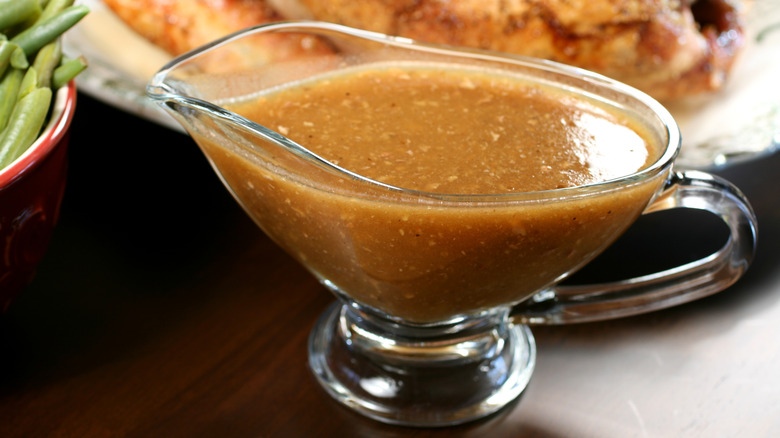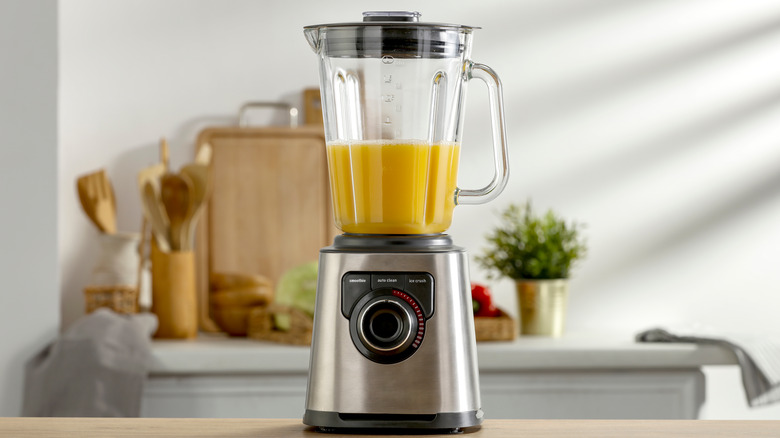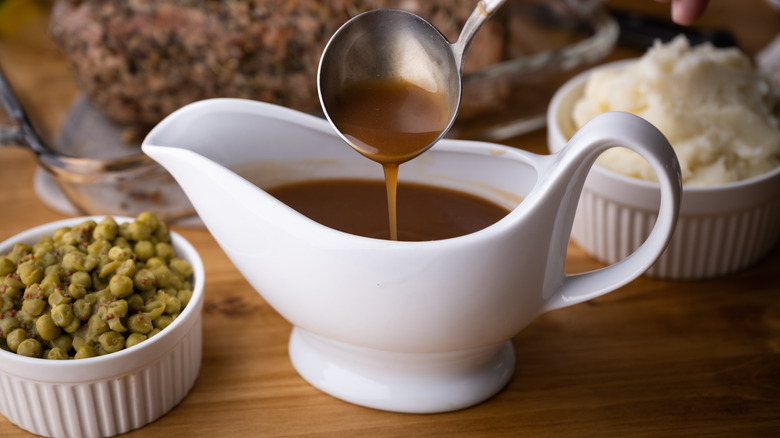What To Do When Your Gravy Turns Out Horribly Lumpy
Gravy sounds like a very simple thing to make. It's pretty much flour, drippings or stock, and your choice of butter, heavy cream, or milk all mixed together over low heat until smooth. Most of the time, it is indeed a very simple thing to make. But just because gravy is easy to make doesn't necessarily mean it's always going to come out perfect. You may, for example, end up with greasy gravy, or gravy that's too thick, too watery, or even too lumpy.
If your gravy comes out looking generally unpleasant, you'll be glad to know there's a very simple solution to this problem. If you have a fine-mesh strainer — any kind will do — take your gravy and strain it. As the liquid part of the gravy collects in a baking dish or other vessel underneath, the lumps will gather up in the strainer, waiting to be disposed of.
You may need to use a spoon or fork to really press the gravy out and keep the lumps from blocking up the mesh, or strain the gravy more than once, but it's better than having to start all over again from scratch. If you don't have a mesh strainer, that's fine. You can use another common household kitchen tool — the blender — to help you remove the lumps from your gravy.
A blender can work out lumps
If you don't happen to have a mesh strainer or you don't particularly feel like straining your gravy over and over, you'll be happy to know your blender can do the job just fine. The blender's ability to blend (obviously) can easily work out the lumps that gather in the gravy and allow it to develop that smooth consistency you expect. But this isn't as easy as pouring your gravy into the blender and blending it like you're making a fruit smoothie. There are some easy but key steps you ought to take beforehand.
After you pour your gravy into the blender, check if the lid has a pour spout. If it does, open that up, then cover it with a clean washcloth or dish towel. Start the blender at its lowest possible speed and gradually increase it, stopping every so often to check the texture and consistency of your gravy.
If you don't open the spout and start at a low speed, then the hot liquid (in this case, the gravy) could build up pressure inside the blender. Without any way to relieve this pressure, as Serious Eats notes, the gravy could explode out the top and possibly injure you or others. Fortunately, with the proper safety precautions in mind, you should have absolutely no problem with this method.
But what exactly makes lumps in your gravy to start with? How can you avoid getting any lumps at all?
Lumps are caused by adding too much flour
You might be wondering just how something like gravy can even get lumps. It's a liquid, after all, isn't it? The answer is that these lumps aren't actually solids, exactly, but instead, semi-solid clumps of flour that have become stuck together during the cooking process.
The reason you get lumps in your gravy may be that you add too much flour to the roux. This excess flour cooks instead of blending together with the butter and the stock or drippings, making that potent raw flour smell as you mix it together. The cooked flour then forms into semi-solid clumps, bonding together instead of sticking and dissolving into the fats of the roux. There's no harm if you were to accidentally consume one, but needless to say, it probably wouldn't taste all that good.
To prevent lumpy gravy, you actually have a few options in mind. You can first continue to whisk your gravy as it warms up, letting the residual gentle heat break down the lumps until it smooths back out. You can also use the strainer to lightly sift the flour into the roux, allowing any clumps of flour that haven't broken up yet to separate and "snow" into the saucepan below. You could also just keep an eye on how much flour you're using, adding small amounts while you mix instead of adding the whole amount all at once.


